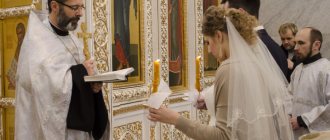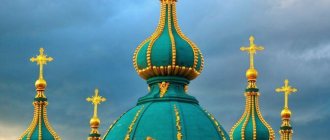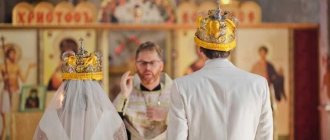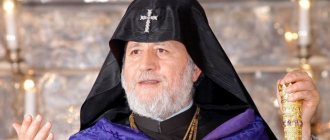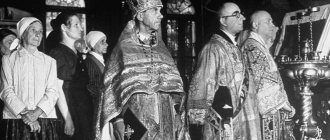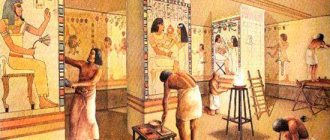Bishops
Photo: Aif.ru
This is the highest sacred rank. Directly translated from Greek, this concept is translated as “bishop” or “overseer.” A clergyman becomes a bishop after the Sacrament of Ordination, otherwise known as Ordination. It is conducted by a council of bishops, that is, several clergy of this rank gathered together.
In the Orthodox tradition, bishops are vested with the same powers as the apostles. They head parishes and are also the immediate supervisors of the clergy. Has the right to conduct all Sacraments without exception.
Bishops are considered equal in grace, however, in order to receive help in difficult situations, some bishops are given additional rights.
Patriarch
This is the bishop who leads the Orthodox Church in the entire state. This title is literally translated from Greek as “family” and “commander.”
At the same time, in some Orthodox countries the church is led by an archbishop, for example, in Poland or Greece. In Georgia and Albania, the Catholicos is the head, and the Alexandrian and Roman churches are ruled by the pope.
Metropolitan
It seems to be translated from Greek as “metropolitan”. A metropolitan is the name given to the leader of a large church region. In Orthodoxy it is called a diocese.
In their structure, dioceses are divided into deaneries, and an even smaller territorial unit is a parish. Metropolitan is an honorary priestly title, which is also a kind of reward for many years of service to the church or special merits.
Archbishop
In early Christianity, the rank of archbishop in the church hierarchy was higher than the metropolitan. Under his direct jurisdiction were several metropolises that were subordinate to him.
Currently, in the Russian Orthodox Church, archbishop is an honorary rank preceding metropolitan.
Bishop
A priest in the rank of bishop presides over a relatively small territory. In some cases, he has an independent area of administration or he may be an assistant to a senior bishop. In this case, he is called vicar. That is, he himself does not have his own diocese to manage, but is obliged to help the local bishop in leadership.
Spiritual orders and ranks
The original meaning of the word “Church” is a meeting of Christ’s disciples, Christians; translated as “meeting”. The concept of “Church” is quite broad: it is a building (in this meaning of the word church and temple are one and the same!), and a meeting of all believers, and a regional meeting of Orthodox people - for example, the Russian Orthodox Church, the Greek Orthodox Church.
Also, the Old Russian word “cathedral”, translated as “assembly”, still refers to congresses of the episcopate and lay Christians to this day (for example, the Ecumenical Council is a meeting of representatives of all Orthodox regional Churches, the Local Council is a meeting of one Church).
The Orthodox Church consists of three orders of people:
- Lay people are ordinary people who are not ordained and do not work in the church (parish). The laity are often called “the people of God.”
- Clergy are laymen who are not ordained to the priesthood, but who work in the parish.
- Priests, or clergy and bishops.
First, we need to talk about the clergy. They play an important role in the life of the Church, but they are not consecrated or ordained through the Sacraments of the Church. This category of people includes professions of different importance:
- Watchmen, cleaners at the temple;
- The elders of churches (parishes are people like the caretaker);
- Employees of the office, accounting and other departments of the Diocesan Administration (this is an analogue of the city administration; even non-believers can work here);
- Readers, altar servers, candle bearers, psalm-readers, sextons - men (sometimes nuns) who serve at the altar with the blessing of the priest (once these positions were different, now they are mixed);
- Singers and regents (conductors of a church choir) - for the position of regent you need to receive the appropriate education at a theological school or seminary;
- Catechists, diocesan press service employees, youth department employees are people who must have a certain deep knowledge of the Church; they usually complete special theological courses.
Some clergy may have distinctive clothing - for example, in most churches, except for poor parishes, male altar servers, readers and candle bearers are dressed in brocade surplices or cassocks (black clothing is slightly narrower than the cassock); At festive services, choristers and directors of large choirs dress in freeform, custom-made, pious clothing of the same color.
Let us also note that there is such a category of people as seminarians and academicians. These are students of Theological schools - schools, seminaries and academies - where future priests are trained. This gradation of educational institutions corresponds to a lay school or college, an institute or university, and a postgraduate or master's degree. Students usually, in addition to studying, perform obediences in the church at the Theological School: they serve at the altar, read, and sing.
There is also the title of subdeacon. This is a person who helps the bishop in worship (taking out the staff, bringing a basin for washing hands, putting on liturgical clothes). A subdeacon can also be a deacon, that is, a clergyman, but most often it is a young man who does not have holy orders and performs only the duties of a subdeacon.
Priests
Photo: Aif.ru
This is the next level of priesthood, the name of which comes from the Greek words “elder”, “leader of the community”. It is among them that black and white clergy are distinguished.
Secular clergy
Those who belong to the white clergy have the titles:
- protopresbyter - this title is awarded to visibly highlight one of the priests for many years of honest service or especially outstanding services.
- archpriest - from Greek this word is translated as “first priest.”
- priest.
Black clergy
Representatives of the black clergy have the titles:
- archimandrite - in modern practice, is the head of a significant or large monastery. In the days of early Christianity, this was the name given to a person who led several monasteries at the same time, for example, throughout the entire metropolis at once. In some situations, a clergyman was made an archimandrite as a kind of reward. If we talk about the white clergy, then this title corresponds to the position of protopresbyter, as well as archpriest.
- abbot - from Greek this title is translated as “leading”. He is considered the immediate leader of the monks, in ancient times and currently the abbot of the monastery. In some local Orthodox churches, this title is used as a kind of hierarchical reward. This practice in the Russian Orthodox Church was finally abolished in 2011.
- hieromonk - a priest of monks.
Second level of the priestly hierarchy
Looking further at church ranks in ascending order, we should focus on priests. Holders of this rank are also called presbyters (in Greek, “elder”), or priests, and in monasticism, hieromonks. Compared to deacons, this is a higher level of priesthood. Accordingly, upon ordination a greater degree of the Grace of the Holy Spirit is acquired.
Since evangelical times, priests have been leading divine services and have the right to perform most of the holy sacraments, including everything except ordination, that is, ordination, as well as the consecration of antimensions and the world. In accordance with the official responsibilities assigned to them, priests lead the religious life of urban and rural parishes, in which they can hold the post of rector. The priest is directly subordinate to the bishop.
For long and impeccable service, a priest of the white clergy is rewarded with the title of archpriest (chief priest) or protopresbyter, and a black priest is rewarded with the rank of abbot. Among the monastic clergy, the abbot, as a rule, is appointed to the position of rector of an ordinary monastery or parish. If he is entrusted with leading a large monastery or monastery, he is called an archimandrite, which is an even higher and more honorable title. It is from the archimandrites that the episcopate is formed.
Deacons
Photo: Aif.ru
White clergy
- deacon
- protodeacon - senior deacon
Black clergy
- hierodeacon
- archdeacon - senior hierodeacon
This is the third degree of priesthood in the Russian Orthodox Church. In monasticism, the analogue of deacons are hierodeacons.
These priests do not have the right to perform and conduct the Sacraments. Their task is to organize assistance to priests and bishops during the celebration of the Sacraments.
In cathedrals there is a position of senior deacon, who is called protodeacon. The senior deacons in monasteries are archdeacons. It is worth noting that receiving this title indicates primacy of honor, but not power.
A little theory
A deacon is the first level of priesthood in the Church. All priests were first deacons. A deacon differs from a priest in that he cannot independently serve the liturgy and perform the sacraments. During consecration, he kneels on one knee; this is an image of the fact that he is not entrusted with full priestly service, but only part of it: he has the right to serve at the Holy Mysteries, but cannot perform them.
The deacon embellishes the service with his voice and assists the priest. He proclaims litanies, reads the Holy Scriptures - the Gospel, and if there are two deacons at the service, then the Apostle - participates in censing and performing some liturgical actions. Most deacons have good voice and hearing. This is especially true for those who serve under the bishop: during bishop's services there are many hymns that are sung in the altar, therefore, in order for the service to be beautiful, one must sing well and competently.
In addition to his liturgical duties, the deacon is responsible for the cleanliness of the altar, the appearance of the service, and the safety of church vessels and utensils. There are places in the altar that sextons cannot touch - this is the Throne, it is in the center, the antimins lies on it, and the Altar - it is located to the side, on which they perform proskomedia. They can only be touched by priests and deacons, who are responsible for the cleanliness of these sacred places.
Clergymen
It is also necessary to identify clergy in the Orthodox Church. This is the lowest level in the church hierarchy. These include:
- readers (they are also called psalm-readers);
- subdeacons (deacon's assistants);
- singers (sacristans);
- altar servers (cleric bearers or sextons).
Church ministers have the right to read and sing during Divine services - everything except the Gospel. They also keep the temple neat and clean.
( 39 ratings, average: 4.62 out of 5)
Primate of the Orthodox Church
And finally, the highest rank of the church hierarchy is the patriarch. He is elected by the Council of Bishops and, together with the Holy Synod, exercises leadership over the entire local church. According to the Charter adopted in 2000, the rank of patriarch is for life, but in some cases the bishop's court is given the right to try him, depose him and decide on his retirement.
In cases where the patriarchal see is vacant, the Holy Synod elects a locum tenens from among its permanent members to perform the functions of the patriarch until his legal election.
